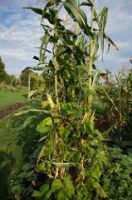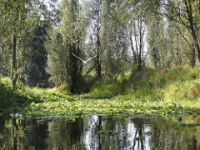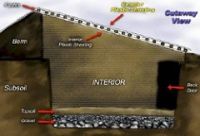Learning from Native Cultures in Garden Design

Many indigenous cultures around the world knew that mimicking the natural forest ecosystem to grow food is a sustainable and productive way to garden. Over the years, much of this indigenous wisdom about 'forage' style forest gardening was lost. But permaculture reclaims this idea and adapts it to different garden settings around the world. To grow your own – but with perennial plants in a low impact system, rather than growing annual plants intensively could be a great choice for many modern-day gardeners with busy lives.
 'Three Sisters' Companion Planting Technique
'Three Sisters' Companion Planting Technique
When native cultures did undertake agricultural planting of annual crops, they often developed companion planting schemes that are still used and valued to this day. One great example of this is the 'three sisters' companion planting technique, in which sweetcorn, beans and squash are grown together. These plants help eat other. The sweetcorn provides a support for the beans, the beans fix nitrogen from the air to the benefit of the whole system, and the squash shades the soil and provides ground cover which helps to retain moisture during the summer months.
 Terra Preta ('Amazonian Black Earth')
Terra Preta ('Amazonian Black Earth')
Another useful garden idea that comes from the other side of the Atlantic is the use of biochar (a compost/charcoal mix) to fertilise the soil of growing areas. Amazonian tribes created what became known as terra preta (Amazonian black earth), which allowed them to increase their yield when growing crops. Biochar, as it is now known, is a useful additive for an organic garden, especially in areas where the soil is sandy and particularly free-draining.
 Chinampas (Floating Aztec Islands)
Chinampas (Floating Aztec Islands)
Aquaponics is another modern idea that indigenous cultures thought of first. While modern aquaponics systems are often high tech, using modern technology to rear fish and plants in a combined system, the Aztex grew plants on floating islands of soil, called chinampas, on fishing lakes and waterways. These chinampas could provide inspiration for your own low-tech hydroponic or aquaponic system.
 Walipini (Underground/ Earth Sheltered Greenhouse)
Walipini (Underground/ Earth Sheltered Greenhouse)
One final idea with thinking about when coming up with designs for your food garden is the walipini. The walipini is an underground greenhouse used by tribes in the Bolivian highlands. While a deep pit would be shaded for too much of the year, we can learn from this idea about the idea of gaining some heat in winter from the earth. An earth sheltered greenhouse or polytunnel, with earth banked to the north side, could stay warmer in winter and allow you to grow a wider range of plants without paying for heating.